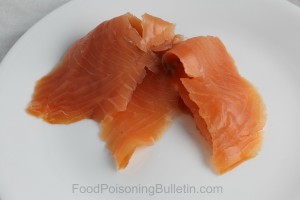One of the biggest problems with the Listeria monocytogenes bacteria is that it grows at refrigerator temperatures. That means that refrigeration, one of the methods traditionally used to control bacterial growth on food, does not work for this pathogen. Now scientists are learning how Listeria grows in vacuum-packed smoked salmon.
 The study, published in the journal American Society for Microbiology discovered that Listeria uses different metabolic pathways when it grows on salmon than those used when cultured in the laboratory. Principle investigator Dr. Teresa Bergholz, who is the assistant professor in the Department of Veterinary and Microbiological Sciences at North Dakota State University-Fargo said, “there may be ways we can use this information to control the pathogen both in foods as well as in infected people.”
The study, published in the journal American Society for Microbiology discovered that Listeria uses different metabolic pathways when it grows on salmon than those used when cultured in the laboratory. Principle investigator Dr. Teresa Bergholz, who is the assistant professor in the Department of Veterinary and Microbiological Sciences at North Dakota State University-Fargo said, “there may be ways we can use this information to control the pathogen both in foods as well as in infected people.”
When the bacteria grows on salmon, it up regulates genes that let it use two compounds from cell membranes as sources of energy. Listeria and Salmonella use those genes to grow in human gastrointestinal tracts too.
Bergholz continued, “understanding how a foodborne pathogen adapts to environmental stresses it encounters on a specific food could allow food microbiologists to develop inhibitors of metabolic or stress response pathways that are necessary for the pathogen to grow or survive on that product.” The environmental stresses in smoked salmon that would affect bacteria are salt content and pH.
Even when lab cultures are modified to mimic the pH and salt content in smoked salmon, the bacteria still act differently in the fish itself. Bergholz also said, “in many cases, the addition of organic acids will slow or stop the growth of this pathogen on ready to eat meats and seafood.”
Food safety experts recommend that those in high risk groups, such as the elderly, children, pregnant women, and those with chronic illnesses or compromised immune systems, avoid eating uncooked smoked salmon and other similar products that are a higher risk. Those products can be heated to at least 165°F to kill the bacteria by baking, grilling, or microwaving them. Hot dogs, lunch meats, and cold cuts also fall into that risky category and should be cooked before serving.




